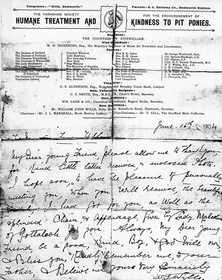Humane treatment and kindness to pit ponies
© National Coal Mining Museum for England (Photo: National Coal Mining Museum for England)
© National Coal Mining Museum for England (Photo: National Coal Mining Museum for England)
The first legislation to protect horses underground was part of the Coal Mines Regulation Act of 1887. Under its limited provisions, the mines inspector could investigate how the horses were treated and whether roofs were high enough to prevent damage to the horses' backs.
In 1911 major protective legislation followed protests by groups such as the National Equine Defence League and a subsequent Royal Commission Report. This Pit Ponies' Charter governed, among other things, the condition of stables, daily record keeping and the provision of a competent horseman for every fifteen horses. Ponies had to be at least four years' old before they could start work underground, and continued until they were no longer fit, often in to their twenties. The popular belief that pit ponies go blind underground is untrue, and the use of blind ponies was prohibited.
Some ponies did go blind from old age and until effective leather headgear with eye guards was designed many ponies injured their eyes at work. Further legislation in 1949 and 1956 regulated conditions even more carefully. These amendments provided for their welfare in greater detail.
In 1911 major protective legislation followed protests by groups such as the National Equine Defence League and a subsequent Royal Commission Report. This Pit Ponies' Charter governed, among other things, the condition of stables, daily record keeping and the provision of a competent horseman for every fifteen horses. Ponies had to be at least four years' old before they could start work underground, and continued until they were no longer fit, often in to their twenties. The popular belief that pit ponies go blind underground is untrue, and the use of blind ponies was prohibited.
Some ponies did go blind from old age and until effective leather headgear with eye guards was designed many ponies injured their eyes at work. Further legislation in 1949 and 1956 regulated conditions even more carefully. These amendments provided for their welfare in greater detail.


